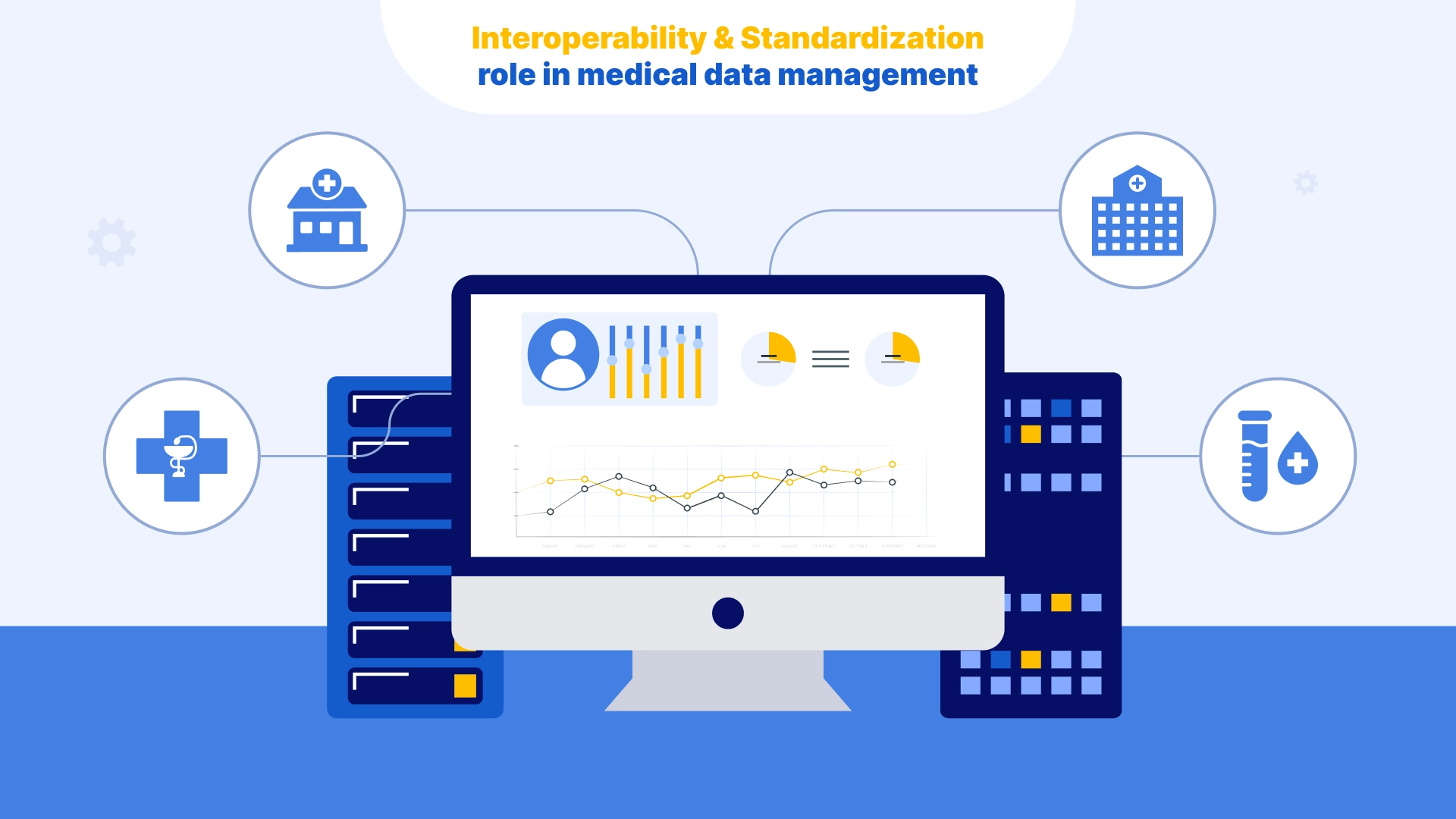

Best Practices of Health Data Management That Healthcare IT Can Adopt
In today’s digital age, efficient and effective management of health data has become essential for healthcare organizations to deliver high-quality medical treatment, improve patient outcomes, and streamline operations, among other objectives. However, this task comes with its fair share of challenges. Healthcare institutions face hurdles such as data fragmentation across disparate systems, interoperability issues, data privacy concerns, and the need for secure storage and exchange. These issues hinder the seamless flow of information and pose risks to patient privacy and the overall quality of services. Nevertheless, by adopting standardized approaches, leveraging advanced technologies, and ensuring robust data governance, healthcare IT can overcome these obstacles and harness the true potential of health data for improved outcomes. This article will delve into the best practices to embrace for enhancing health data management.
Data Governance
In the realm of healthcare IT, data governance refers to the comprehensive management and oversight of health data throughout its lifecycle. It encompasses a set of processes, policies, and frameworks designed to ensure the availability, usability, integrity, and security of data. Establishing a structured approach to healthcare data management enables medical organizations to make well-informed decisions, comply with regulations, and optimize data utilization for patient care.
Effective data governance relies on the foundation of policies, procedures, and guidelines. Policies outline the rules and principles governing health data collection, storage, access, and sharing. Procedures provide step-by-step processes for healthcare information management, including data entry, validation, and maintenance. Guidelines offer recommendations and best practices for data handling, promoting uniformity and consistency. These elements ensure compliance with legal and regulatory requirements, enhance patient confidence and facilitate evidence-based decision-making in healthcare.
Interoperability & Standardization

Interoperability plays a crucial role in medical data management as it enables the integration and sharing of information across diverse healthcare settings, including hospitals, clinics, laboratories, and pharmacies. It enhances care coordination, reduces the need for duplicate data entry, and empowers healthcare providers with comprehensive patient information at the point of care.
Moreover, interoperability encompasses the ability of systems to interpret and understand exchanged data, ensuring the delivery of meaningful and actionable information. It facilitates the efficient transfer of data between Electronic Health Record (EHR) systems, healthcare analytics platforms, telehealth solutions, and other health IT systems, promoting collaboration and continuity of care.
When it comes to standards, they define the structure, format, and content of health data, ensuring consistency and uniformity across systems. By adopting widely accepted standards such as Health Level 7 (HL7), Digital Imaging and Communications in Medicine (DICOM), and Fast Healthcare Interoperability Resources (FHIR), healthcare IT can achieve seamless information exchange, regardless of the underlying technology or vendor.
Adhering to data standards brings numerous benefits. Firstly, it improves information accuracy and completeness by providing clear guidelines for data capture and representation. Secondly, it facilitates efficient data exchange and integration, reducing manual effort and time spent on data reconciliation. Thirdly, it supports data analytics and population health management, enabling organizations to derive insights from aggregated and standardized data sets. Finally, information standards future-proof healthcare IT investments by ensuring compatibility and interoperability as technology evolves.
Data Privacy & Security
Patient privacy and confidentiality are of utmost importance in health data management. Safeguarding it involves implementing rigorous access controls, consent mechanisms, and privacy policies. It also requires educating healthcare professionals on privacy practices to ensure responsible handling of patient data and compliance with regulations.
In order to enhance data security, healthcare IT can adopt various best practices:
Encryption: Implementing encryption techniques, such as Secure Socket Layer (SSL) and Advanced Encryption Standard (AES), helps protect data both during transit and when at rest.
Access Controls: Role-Based Access Control (RBAC), Two-Factor Authentication (2FA), and strong password policies are effective mechanisms for restricting information access based on user roles and verifying user identities.
Data Minimization: Reducing the storage of excessive or unnecessary data helps mitigate associated risks.
Regular Security Audits: Conducting periodic security audits evaluates the effectiveness of security controls, assesses risks, and enables organizations to take corrective actions to strengthen data security.
Employee Training: Providing comprehensive training to employees on identifying phishing emails, recognizing potential security threats, and adhering to security policies and procedures is essential.
Furthermore, healthcare organizations must comply with regulatory frameworks that govern information privacy and security. Two notable regulations are the Health Insurance Portability and Accountability Act (HIPAA) in the United States and the General Data Protection Regulation (GDPR) in the European Union. HIPAA requires healthcare providers, health plans, and business associates to implement safeguards to protect patient data, maintain confidentiality, and provide patients with control over their information. GDPR places obligations on organizations, including healthcare entities, to ensure transparent data handling practices, obtain explicit consent, and implement appropriate security measures to protect personal information. Compliance with these regulatory frameworks is crucial for healthcare IT to demonstrate a commitment to patient privacy and avoid legal penalties.
Data Analytics & Insights
Data analytics plays a vital role in healthcare, empowering professionals to gain deeper insights into patient populations, identify high-risk individuals, and implement proactive interventions. It also supports population health management initiatives, enabling healthcare organizations to target specific health issues, monitor outcomes, and allocate resources effectively.
To achieve effective data analytics, it is crucial to integrate and aggregate information from various sources. This process provides a comprehensive view of the patient’s health status, medical history, and treatment outcomes.
While data analytics offers immense potential, it also presents ethical considerations and challenges. Anonymizing patient data is essential to protect privacy and confidentiality. By removing identifying information, healthcare organizations can ensure that individuals cannot be directly identified from the analyzed data. Additionally, obtaining patient consent for data analysis is important to respect individual autonomy and ensure transparency.
Healthcare IT should prioritize privacy protection, maintain transparency, and engage in ongoing dialogue with patients and stakeholders to establish trust and foster a patient-centric approach to data analytics.
Data Backup & Disaster Recovery
Data backup and disaster recovery practices are essential for protecting health data from loss, system failures, natural disasters, or other unexpected events. In the healthcare industry, ensuring data availability and recoverability is of utmost importance.
An effective data backup strategy should include the following key elements:
Regular Backups: Consistently and reliably backing up health data, including both on-premises and off-site backups, helps mitigate the risk of data loss.
Redundancy: Storing backups in multiple locations or utilizing redundant systems helps safeguard against data loss caused by hardware failures or disasters.
Data Validation: Verifying the completeness and accuracy of backup data, along with performing periodic recovery tests, ensures the data’s recoverability.
Off-Site Storage: Storing backups in off-site locations, such as cloud-based storage or remote data centers, adds an extra layer of protection against physical damage, theft, or localized disasters that may affect the primary data center.
Disaster recovery planning involves developing strategies and procedures to restore critical IT systems and data in the event of a disaster or system failure. Its objective is to minimize downtime, ensure operational continuity, and reduce the impact on patient care.
Key aspects of a comprehensive disaster recovery plan include:
Business Impact Analysis: Conducting a thorough assessment of potential risks and their impact on data availability, while prioritizing critical systems and data for recovery.
Recovery Point Objective (RPO) & Recovery Time Objective (RTO): Defining acceptable levels of data loss (RPO) and the maximum tolerable downtime (RTO) for different systems and applications. This helps determine the backup frequency and the speed of recovery required for each system.
Backup Restoration Procedures: Document step-by-step procedures for restoring backups and recovering systems, including the necessary hardware, software, and network configurations.
Communication & Notification: Establishing clear communication channels and protocols to inform key stakeholders, such as staff, patients, and regulatory authorities, about the disaster recovery process and expected downtime.
By implementing a robust data backup strategy and disaster recovery plan, healthcare IT can minimize the impact of potential data loss or system failures, ensuring the continuity of patient care and safeguarding critical health data.
Final Word
Effective management of health data is vital for the healthcare sector to enhance patient care, foster innovation, and achieve better healthcare outcomes. This can be achieved through the implementation of best practices, including the establishment of robust data governance frameworks, ensuring data quality and security, leveraging data analytics for valuable insights, implementing strategies for data backup and disaster recovery, developing data retention policies, and prioritizing interoperability for seamless data exchange.
By embracing these techniques, healthcare IT can unlock the full potential of health data, enabling evidence-based decision-making, improved care coordination, enhanced patient safety, and effective management of population health initiatives.
Faq
Why is health data management important in healthcare IT?
+Health data management enables secure storage, retrieval, and exchange of patient information, facilitating timely and accurate diagnoses and treatment decisions. It also promotes research and healthcare advancements. Anonymized and aggregated data can be analyzed to identify trends, patterns, and emerging health issues, leading to the development of new treatments or preventive measures.
What are the key challenges in health data management?
+The key challenges in medical data management include ensuring data privacy and security, maintaining information integrity and quality, interoperability of different systems, managing the vast volume of data generated, and addressing ethical and legal considerations. Keeping up with technological advancements and evolving regulatory frameworks adds complexity to the process.
How can healthcare IT ensure data security?
+Robust encryption techniques should be employed to protect sensitive data during transmission and storage. Access controls should be implemented, granting appropriate privileges only to authorized personnel. Regular system audits and vulnerability assessments help identify and address security weaknesses. Compliance with regulatory standards is also crucial.
What role does data governance play in health data management?
+Data governance ensures that information is handled securely, ethically, and efficiently. It establishes policies, procedures, and standards for data collection, storage, access, and usage as well as helps maintain integrity and privacy, complying with regulations like HIPAA. Effective data governance promotes interoperability, facilitating better patient care, research, and public health initiatives.
Tell us about your project
Fill out the form or contact us

Tell us about your project
Thank you
Your submission is received and we will contact you soon
Follow us
